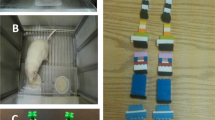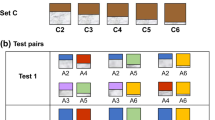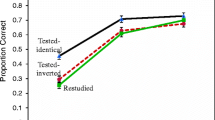Abstract
The present study examined paired-associate learning with color and olfactory stimuli. Separate groups of undergraduate students learned pairs comprised of homogenous colors or scents, or pairs containing both colors and scents in which the order of presentation was manipulated. The results showed that learning was greater with colors than olfactory stimuli. More importantly, the learning task was affected by temporal order. Performance was significantly reduced when the odor element appeared first in the paired presentations. When the scent elements appeared second, learning was rapid and was similar to that which occurred in the group presented with homogenous colors. Discussion focused on the ecological nature of olfactory processing and encoding strategies.
Similar content being viewed by others
References
CAIN, W. S. (1979). To know with the nose: Keys to odor identification. Science, 467–470.
DAVIS, R. G. (1975). Acquisition of verbal associations to olfactory stimuli of varying familiarity and to abstract visual stimuli. Journal of Experimental Psychology, Human Learning and Memory, 104, 134–142.
DAVIS, R. G. (1977). Acquisition and retention of verbal associations to olfactory and abstract visual stimuli of varying similarity. Journal of Experimental Psychology, Human Learning and Memory, 3, 37–51.
ENGEN, T. (1982). The perception of odors. New York: Academic Press.
ENGEN, T. (1987). Remembering odors and their names. American Scientist, 75, 497–503.
ENGEN, T. (1989). Odor sensation and memory. Praeger Press.
GABASSI, P. G., & ZANUTTINI, L. (1983). Riconoscimento di stimoli olfattivi nella a memoria a breve termine [Recognition of olfactory stimuli in shortterm memory]. Giornale Italiano di Psicologia, 10, 51–60.
RABIN, M. D., & CAIN, W. S. (1984). Odor recognition: Familiarity, identity, and encoding consistency. Journal of Experimental Psychology: Learning, Memory, and Cognition, 10, 316–325.
RICHARDSON, J. T. E., & ZUCCO, G. M. (1989). Cognition and olfaction: A review. Psychological Bulletin, 105, 352–360.
RUBIN, D. C., GROTH, E., & GOLDSMITH, D. J. (1984). Olfactory cuing of autobiographical memory. American Journal of Psychology, 97, 493–507.
SCHAB, F. R. (1991). Odor memory: Taking stock. Psychological Bulletin, 109, 242–251.
Author information
Authors and Affiliations
Additional information
A portion of this research was supported by a National Science Foundation Grant USE#-9153165. Thanks are extended to Trygg Engen, Frank Schab, Henry Cross, and all those at Llanfair MN for providing constructive comments on earlier drafts.
Rights and permissions
About this article
Cite this article
Bowers, R.L., Doran, T.P., Edles, P.A. et al. Paired-Associate Learning with Visual and Olfactory Cues: Effects of Temporal Order. Psychol Rec 44, 501–507 (1994). https://doi.org/10.1007/BF03395140
Published:
Issue Date:
DOI: https://doi.org/10.1007/BF03395140




